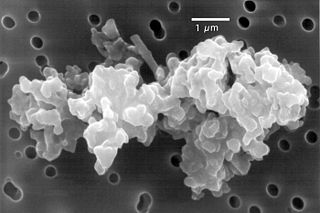Infrared astronomy is a sub-discipline of astronomy which specializes in the observation and analysis of astronomical objects using infrared (IR) radiation. The wavelength of infrared light ranges from 0.75 to 300 micrometers, and falls in between visible radiation, which ranges from 380 to 750 nanometers, and submillimeter waves.

The Spitzer Space Telescope, formerly the Space Infrared Telescope Facility (SIRTF), is an infrared space telescope launched in 2003, that was deactivated when operations ended on 30 January 2020. Spitzer was the third space telescope dedicated to infrared astronomy, following IRAS (1983) and ISO (1995–1998). It was the first spacecraft to use an Earth-trailing orbit, later used by the Kepler planet-finder.
Gusto, El Gusto or GUSTO may refer to:

The Stratospheric Observatory For Infrared Astronomy (SOFIA) was a 80/20 joint project of NASA and the German Aerospace Center (DLR) to construct and maintain an airborne observatory. NASA awarded the contract for the development of the aircraft, operation of the observatory and management of the American part of the project to the Universities Space Research Association (USRA) in 1996. The DSI managed the German parts of the project which were primarily science-and telescope-related. SOFIA's telescope saw first light on May 26, 2010. SOFIA was the successor to the Kuiper Airborne Observatory. During 10-hour, overnight flights, it observed celestial magnetic fields, star-forming regions, comets, nebulae, and the Galactic Center.

The Herschel Space Observatory was a space observatory built and operated by the European Space Agency (ESA). It was active from 2009 to 2013, and was the largest infrared telescope ever launched until the launch of the James Webb Space Telescope in 2021. Herschel carries a 3.5-metre (11.5 ft) mirror and instruments sensitive to the far infrared and submillimetre wavebands (55–672 μm). Herschel was the fourth and final cornerstone mission in the Horizon 2000 programme, following SOHO/Cluster II, XMM-Newton and Rosetta.

The Columbia Scientific Balloon Facility (CSBF), established in 1961 and formerly known as the National Scientific Balloon Facility (NSBF), is a NASA facility responsible for providing launch, tracking and control, airspace coordination, telemetry and command systems, and recovery services for unmanned high-altitude balloons. Customers of the CSBF include NASA centers, universities, and scientific groups from all over the world.

The NASA Infrared Telescope Facility is a 3-meter (9.8 ft) telescope optimized for use in infrared astronomy and located at the Mauna Kea Observatory in Hawaii. It was first built to support the Voyager missions and is now the US national facility for infrared astronomy, providing continued support to planetary, solar neighborhood, and deep space applications. The IRTF is operated by the University of Hawaii under a cooperative agreement with NASA. According to the IRTF's time allocation rules, at least 50% of the observing time is devoted to planetary science.

A superpressure balloon (SPB) is a style of aerostatic balloon where the volume of the balloon is kept relatively constant in the face of changes in ambient pressure outside the balloon, and the temperature of the contained lifting gas. This allows the balloon to keep a stable altitude for long periods. This is in contrast with much more common variable-volume balloons, which are either only partially filled with lifting gas, or made with more elastic materials. Also referred to as pumpkin or ultra long distance balloons (ULDB) balloons, the sealed balloon envelopes have a pumpkin shape at flight altitude.

Cosmic dust – also called extraterrestrial dust, space dust, or star dust – is dust that occurs in outer space or has fallen onto Earth. Most cosmic dust particles measure between a few molecules and 0.1 mm (100 μm), such as micrometeoroids and meteoroids. Cosmic dust can be further distinguished by its astronomical location: intergalactic dust, interstellar dust, interplanetary dust, and circumplanetary dust. There are several methods to obtain space dust measurement.
Frank James Low was a solid state physicist who became a leader in the new field of infrared astronomy, after inventing the gallium doped germanium bolometer in 1961. This detector extended the range of the observable spectrum to much longer wavelengths.

SRON Netherlands Institute for Space Research (SRON) is a national Dutch institute for space research. It develops and uses innovative technology for analysis in space, focusing on astrophysical research, Earth observation, and exoplanetary research. SRON research includes new and more advanced sensors for X-rays, infrared radiation, and visible light.

An infrared telescope is a telescope that uses infrared light to detect celestial bodies. Infrared light is one of several types of radiation present in the electromagnetic spectrum.

A balloon-borne telescope is a type of airborne telescope, a sub-orbital astronomical telescope that is suspended below one or more stratospheric balloons, allowing it to be lifted above the lower, dense part of the Earth's atmosphere. This has the advantage of improving the resolution limit of the telescope at a much lower cost than for a space telescope. It also allows observation of frequency bands that are blocked by the atmosphere.

The kinetic inductance detector (KID) — also known as a microwave kinetic inductance detector (MKID) — is a type of superconducting photon detector first developed by scientists at the California Institute of Technology and the Jet Propulsion Laboratory in 2003. These devices operate at cryogenic temperatures, typically below 1 kelvin. They are being developed for high-sensitivity astronomical detection for frequencies ranging from the far-infrared to X-rays.

The SAFARI imaging spectrometer was the European image sensor of Japanese infrared telescope SPICA and is being developed under the leadership of SRON Netherlands Institute for Space Research. SAFARI is an infrared camera with about 6,000 pixels that can make real ‘photos’ of the sky in three adjacent wavelength areas. Fourier transform spectroscopy (FTS) obtains detailed spectral information, allowing astronomers to determine the chemical composition of the observed celestial sources. The Netherlands Organisation for Applied Scientific Research (TNO) is developing the mechanism of this FTS.

The Balloon Rapid Response for ISON (BRRISON) was a NASA project involving a stratospheric balloon with science instruments intended to study comet C/2012 S1 (ISON) and other celestial objects.

Origins Space Telescope (Origins) is a concept study for a far-infrared survey space telescope mission. A preliminary concept in pre-formulation, it was presented to the United States Decadal Survey in 2019 for a possible selection to NASA's large strategic science missions. Origins would provide an array of new tools for studying star formation and the energetics and physical state of the interstellar medium within the Milky Way using infrared radiation and new spectroscopic capabilities.

The Super-pressure Balloon-borne Imaging Telescope (SuperBIT) is a highly stabilized, high-resolution telescope that operates in the stratosphere via NASA's superpressure balloon (SPB) system. At 40 km altitude above sea level, the football-stadium-sized balloon carries SuperBIT to a suborbital environment above 99.2% of the Earth's atmosphere in order to obtain space-quality imaging. As a research instrument, SuperBIT's primary science goal is to provide insight into the distribution of dark matter in galaxy clusters and throughout the large-scale structure of the universe. As demonstrated by numerous test flights, the survey data generated by SuperBIT is expected to have similar quality and data collection efficiency as the Hubble Space Telescope while complementing surveys from other up-and-coming observatories such as the James Webb Space Telescope (JWST), the Vera C. Rubin Observatory, and the Nancy Grace Roman Space Telescope.
















